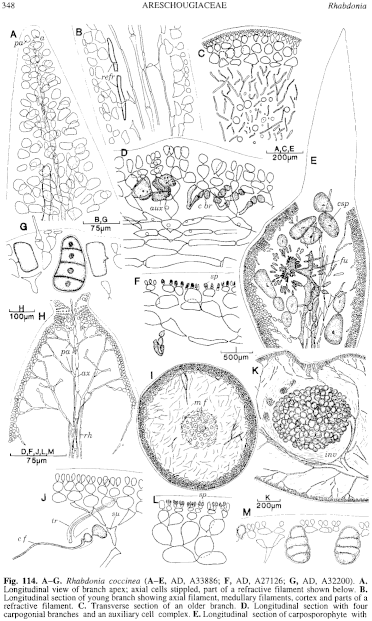|
|
|
|
|
|||||||||||
|
Electronic Flora of South Australia Species Fact Sheet
Phylum Rhodophyta – Class Florideophyceae – Order Gigartinales – Family Areschougiaceae
Selected citations: J. Agardh 1872: 38; 1876: 594. Kylin 1932: 36, fig. 7A–C. Lucas & Perrin 1947: 172, fig. 43a-f. Min-Thein & Womersley 1976: 43, figs 15, 16, 55A.
Synonym
Chondria articulata var. gracilis C. Agardh 1822: 358.
Thallus (Fig. 113B) red-broWn to dark red, erect, 10–25 cm high, profusely branched from apices of elongate-ovoid to clavate segments 2–4 (–6) mm long above, to 10 mm long below, 0.5–1 mm in diameter, lower branches becoming more or less terete by cortical thickening (1–1.5 mm in diameter), and the basal few centimetres covered with short adventitious branchlets 0.5–4 mm long, of 1–3 segments. Holdfast branched, hapteroid, 3–30 mm across, bearing one to several fronds; epilithic. Structure (Fig. 114H) uniaxial, periaxial cells single per axial cell and on three radii, forming a broad medullary region traversed by the branched periaxial filaments but with a central core of rhizoids surrounding
Reproduction: Sexual thalli dioecious; non-procarpic. Carpogonial branches (Fig. 114J) 3-celled, borne on an inner cortical cell or outer medullary cell, directed inwards with a reflexed trichogyne. Connecting filament single (Fig. 114J), non-septate, unbranched. Auxiliary cells not observed. Fusion cell connected to an enlarged medullary filament and bearing radial gonimoblasts (Fig. 114K) with short chains (terminally mature) of ovoid carposporangia 30–60 µm in diameter. Cystocarps within the medulla, 500–800 µm in diameter, only slightly swelling the branch, with slight filamentous enveloping tissue and slightly thickened cortex, ostiolate. Spermatangia (Fig. 114L) scattered, with surface cortical cells cutting off 2–3 initials which form 2–3 ovoid spermatangia 3–4 µm in diameter.
Tetrasporangia (Fig. 114M) scattered in the cortex, cut off laterally, ovoid, 60–80 µm long and 40–50 µm in diameter, protruding into the medulla and with a rosette of cortical cells in surface view, zonately divided.
Type from Georgetown, Tas.; lectotype in Herb. Harvey, TCD.
Selected specimens: Elliston, S. Aust., 7 m deep in bay (Shepherd, 21.x.1970; AD, A37546). Off Troubridge Light, Edithburg, S. Aust., 17 m deep (Shepherd, 4.ii.1969; AD, A33435). Investigator Strait, S. Aust., 23 m deep (Watson, 15.i.1971; AD, A41031). Seal Beach, Kangaroo I., S. Aust., drift (Womersley, 21.i.1965; AD, A28642). Pennington Bay, Kangaroo I., S. Aust., drift (Womersley, 24.v.1945; AD, A16405). Stinky Bay, Nora Creina, S. Aust., drift (Womersley, 19.viii.1957; AD, A21244). Dutton Bay, Portland, Vic., drift (Womersley, 13.iv.1959; AD, A22687). Coles Channel (entrance to Swan Bay), Port Phillip, Vic., 6 m deep (Macpherson, 4.iv.1963; AD, A28680). Crawfish Rock, Westernport Bay, Vic., 3 m deep (Shepherd, 31.i.1970; AD, A35218). Walkerville, Vic., drift (Sinkora A2070, 26.ii.1975; AD, A48317). Great Taylor Bay, Bruny I., Tas., 10 m deep (Shepherd, 7.ii.1970; AD, A35150).
Distribution: Elliston, S. Aust., to Walkerville, Vic., and around Tasmania.
Taxonomic notes: R. verticillata is a distinctive species in habit, in the uniaxial filament being conspicuous only near the apices, and in the presence of short branchlets clothing the lower axes. In the latter two features it differs from Erythroclonium muelleri which is similar in appearance.
References:
AGARDH, C.A. (1822). Species Algarum. Vol. 1, Part 2, pp. 169–398. (Berling: Lund.)
AGARDH, J.G. (1872). Bidrag till Florideernes Systematik. Acta Univ. hind. 8, 1–60.
AGARDH, J.G. (1876). Species Genera et Ordines Algarum. Vol. 3, Part 1 - Epicrisis systematis Floridearum, pp. i-vii, 1–724. (Weigel: Leipzig.)
HARVEY, W.H. (1863). Phycologia Australica. Vol. 5, Plates 241–300, synop., pp. i-lxxiii. (Reeve: London.)
KYLIN, H. (1932). Die Florideenordnung Gigartinales. Lunds Univ. Årsskr. N.F. Avd. 2, 28 (8), 1–88, Plates 1–28.
LUCAS, A.H.S. & PERRIN, F. (1947). The Seaweeds of South Australia. Part 2. The Red Seaweeds. (Govt Printer: Adelaide.)
MIN-THEIN, U. & WOMERSLEY, H.B.S. (1976). Studies on southern Australian taxa of Solieriaceae, Rhabdoniaceae and Rhodophyllidaceae (Rhodophyta). Aust. J. Bot. 24, 1–166.
The Marine Benthic Flora of Southern Australia Part IIIA complete list of references.
Publication:
Womersley, H.B.S. (14 January, 1994)
The Marine Benthic Flora of Southern Australia
Rhodophyta. Part IIIA, Bangiophyceae and Florideophyceae (to Gigartinales)
Reproduced with permission from The Marine Benthic Flora of Southern Australia Part IIIA 1994, by H.B.S. Womersley. Australian Biological Resources Study, Canberra. Copyright Commonwealth of Australia.
Illustrations in Womersley Part IIIA, 1994: FIGS 113B, 114 H–M.

Figure 113 enlarge
Fig. 113. A. Rhabdonia coccinea (AD, A61214). Habit. B. Rhabdonia verticillata (AD, A41031). Habit. C–E. Rhabdonia clavigera. (C, AD, A31637; D, E, AD, A57594). C. Habit. D. Transverse section of branch with a carposporophyte with central fusion cell and radiating gonimoblast filaments with terminal carposporangia. E. Transverse section of cortex with tetrasporangia.

Figure 114 enlarge
Fig. 114. A–G. Rhabdonia coccinea (A–E, AD, A33886; F, AD, A27126; G, AD, A32200). A. Longitudinal view of branch apex; axial cells stippled, part of a refractive filament shown below. B. Longitudinal section of young branch showing axial filament, medullary filaments, cortex and parts of a refractive filament. C. Transverse section of an older branch. D. Longitudinal section with four carpogonial branches and an auxiliary cell complex. E. Longitudinal section of carposporophyte with elongate fusion cell, radiating gonimoblast filaments and displaced carposporangia. F. Longitudinal section of cortex with spermatangia and a carpogonial branch. G. Section of cortex with immature and mature tetrasporangia, and a hair. H–M. Rhabdonia verticillata (H, I, M, AD, A21244; J, K, AD, A16405; L, AD, A35150). H. Longitudinal section of part of a segment, with axial filament, periaxial cells of medulla, and descending rhizoids. I. Transverse section of older branch with axial core and medulla largely filled with rhizoids. J. Section of cortex with a fertilized carpogonial branch producing a connecting filament. K. Longitudinal section with a carposporophyte surrounded by a lax involucre and with four germinating carposporangia. L. Section of cortex with spermatangia. M. Section of cortex with immature and mature tetrasporangia. [A–M after Min-Thein & Womersley 1976.]

|
Email Contact: State Herbarium of South Australia |

|